# Import Libraries
import numpy as np
import pandas as pd
import matplotlib.pyplot as plt
import seaborn as snsExploratory Data Analysis on Car prices Prediction Dataset
Submitted by
Shah Nawaz - (lead)
Saleha Attiq - (co-lead)
Rabia Attiq
Muhammad Abdullah
Naveed ul Mustafa
Khurram Shehzad
Ali Husnain
Karan Kumar
Muhammad Abdullah
Ali Hamza
on 20-08-2022
1- Project Description
A company is planning to build a manufacturing unit. They have gathered car price data from an automobile consulting company of that particular region to understand the factors on which the pricing of cars depends. The company wants to know:
- Which variables are significant in predicting the price of a car
- How well those variables describe the price of a car
2- Objective
To reach an informed business decision and capturing the market following factors need to carefully studied through EDA:
- To find out correlation of price with the available independent variables.
- To plan the strategy for choosing the car design and features which are popular in this market based on the data set.
- To see the trend of price and accordingly set the prices of variants.
3- Methodology
Overview of the data
Checking shape, number of columns and missing values
Check for duplicate rows and drop if insignificant with respect to data size
Drop unnecssary columns with redundant or meaningless values.
Identifying Unique values in all columns
Detecting if there is any pseudo Unique or invalid entries in the columns. If any convert into Null value
Data type casting.
Replace the Null values with the mean.
Check the outlier values and treat them.
Data visualisation of the each categorical and numerical feature using barplot, boxplot, histograms, scatter plot, maps and line graphs.
Find out the Correlation
Step_1 Importing important libraries
Step_2 Overview of dataset
Import Dataset
# Import Dataset
df = pd.read_csv("car_price_prediction.csv")
df.head()| ID | Price | Levy | Manufacturer | Model | Prod. year | Category | Leather interior | Fuel type | Engine volume | Mileage | Cylinders | Gear box type | Drive wheels | Doors | Wheel | Color | Airbags | |
|---|---|---|---|---|---|---|---|---|---|---|---|---|---|---|---|---|---|---|
| 0 | 45654403 | 13328 | 1399 | LEXUS | RX 450 | 2010 | Jeep | Yes | Hybrid | 3.5 | 186005 km | 6.0 | Automatic | 4x4 | 04-May | Left wheel | Silver | 12 |
| 1 | 44731507 | 16621 | 1018 | CHEVROLET | Equinox | 2011 | Jeep | No | Petrol | 3 | 192000 km | 6.0 | Tiptronic | 4x4 | 04-May | Left wheel | Black | 8 |
| 2 | 45774419 | 8467 | - | HONDA | FIT | 2006 | Hatchback | No | Petrol | 1.3 | 200000 km | 4.0 | Variator | Front | 04-May | Right-hand drive | Black | 2 |
| 3 | 45769185 | 3607 | 862 | FORD | Escape | 2011 | Jeep | Yes | Hybrid | 2.5 | 168966 km | 4.0 | Automatic | 4x4 | 04-May | Left wheel | White | 0 |
| 4 | 45809263 | 11726 | 446 | HONDA | FIT | 2014 | Hatchback | Yes | Petrol | 1.3 | 91901 km | 4.0 | Automatic | Front | 04-May | Left wheel | Silver | 4 |
Check the Data Shape
- It is a important step.
- First step to start EDA.
# Data Shape in terms of Row and columns
print('The number of rows are: ', df.shape[0])
print('The number of columns are: ', df.shape[1])The number of rows are: 19237
The number of columns are: 18Structure of Dataset
- In this step we are seeing the structure of Dataset.
- After running a code df.info() we will sees the data type and number of Non-Null values.
# Structure of the data
df.info()<class 'pandas.core.frame.DataFrame'>
RangeIndex: 19237 entries, 0 to 19236
Data columns (total 18 columns):
# Column Non-Null Count Dtype
--- ------ -------------- -----
0 ID 19237 non-null int64
1 Price 19237 non-null int64
2 Levy 19237 non-null object
3 Manufacturer 19237 non-null object
4 Model 19237 non-null object
5 Prod. year 19237 non-null int64
6 Category 19237 non-null object
7 Leather interior 19237 non-null object
8 Fuel type 19237 non-null object
9 Engine volume 19237 non-null object
10 Mileage 19237 non-null object
11 Cylinders 19237 non-null float64
12 Gear box type 19237 non-null object
13 Drive wheels 19237 non-null object
14 Doors 19237 non-null object
15 Wheel 19237 non-null object
16 Color 19237 non-null object
17 Airbags 19237 non-null int64
dtypes: float64(1), int64(4), object(13)
memory usage: 2.6+ MBStep_3 Cleaning of Data
Rename Columns as a good practice
df = df.rename(columns={"Prod. year": "Prod_year",
"Leather interior": "Leather_interior" ,
"Fuel type": "Fuel_type" , "Engine volume": "Engine_volume" ,
"Gear box type": "Gear_box_type" , "Drive wheels": "Drive_wheels"})# Columns of DataFrame
df.columnsIndex(['ID', 'Price', 'Levy', 'Manufacturer', 'Model', 'Prod_year', 'Category',
'Leather_interior', 'Fuel_type', 'Engine_volume', 'Mileage',
'Cylinders', 'Gear_box_type', 'Drive_wheels', 'Doors', 'Wheel', 'Color',
'Airbags'],
dtype='object')Dealing with duplicates
# Checking the duplicates
df.duplicated().sum()313# Dropping the duplicates
df = df.drop_duplicates()# Again checking the duplicates
df.duplicated().sum()0Dropping unncessary columns
df = df.iloc[: , 1:]
df.head()
# ID column is dropped
# By looking it the columns ID does not have any meaningful value| Price | Levy | Manufacturer | Model | Prod_year | Category | Leather_interior | Fuel_type | Engine_volume | Mileage | Cylinders | Gear_box_type | Drive_wheels | Doors | Wheel | Color | Airbags | |
|---|---|---|---|---|---|---|---|---|---|---|---|---|---|---|---|---|---|
| 0 | 13328 | 1399 | LEXUS | RX 450 | 2010 | Jeep | Yes | Hybrid | 3.5 | 186005 km | 6.0 | Automatic | 4x4 | 04-May | Left wheel | Silver | 12 |
| 1 | 16621 | 1018 | CHEVROLET | Equinox | 2011 | Jeep | No | Petrol | 3 | 192000 km | 6.0 | Tiptronic | 4x4 | 04-May | Left wheel | Black | 8 |
| 2 | 8467 | - | HONDA | FIT | 2006 | Hatchback | No | Petrol | 1.3 | 200000 km | 4.0 | Variator | Front | 04-May | Right-hand drive | Black | 2 |
| 3 | 3607 | 862 | FORD | Escape | 2011 | Jeep | Yes | Hybrid | 2.5 | 168966 km | 4.0 | Automatic | 4x4 | 04-May | Left wheel | White | 0 |
| 4 | 11726 | 446 | HONDA | FIT | 2014 | Hatchback | Yes | Petrol | 1.3 | 91901 km | 4.0 | Automatic | Front | 04-May | Left wheel | Silver | 4 |
Now unique value of every column will be checked and listed below those which required treatment. This step is necessary to find out that:
- Whether the column has wrong unique value due to any spelling mistakes
- Whether the column has abnormal unique value which does not correspond to that data column
# check if there zero in price
any(df.Price==0)False# check if there any negative number in price
any(df.Price<0)Falsedf['Levy'].unique()
# This command helped us itdentifying "-" psuedo unique value in Levy columnarray(['1399', '1018', '-', '862', '446', '891', '761', '751', '394',
'1053', '1055', '1079', '810', '2386', '1850', '531', '586',
'1249', '2455', '583', '1537', '1288', '915', '1750', '707',
'1077', '1486', '1091', '650', '382', '1436', '1194', '503',
'1017', '1104', '639', '629', '919', '781', '530', '640', '765',
'777', '779', '934', '769', '645', '1185', '1324', '830', '1187',
'1111', '760', '642', '1604', '1095', '966', '473', '1138', '1811',
'988', '917', '1156', '687', '11714', '836', '1347', '2866',
'1646', '259', '609', '697', '585', '475', '690', '308', '1823',
'1361', '1273', '924', '584', '2078', '831', '1172', '893', '1872',
'1885', '1266', '447', '2148', '1730', '730', '289', '502', '333',
'1325', '247', '879', '1342', '1327', '1598', '1514', '1058',
'738', '1935', '481', '1522', '1282', '456', '880', '900', '798',
'1277', '442', '1051', '790', '1292', '1047', '528', '1211',
'1493', '1793', '574', '930', '1998', '271', '706', '1481', '1677',
'1661', '1286', '1408', '1090', '595', '1451', '1267', '993',
'1714', '878', '641', '749', '1511', '603', '353', '877', '1236',
'1141', '397', '784', '1024', '1357', '1301', '770', '922', '1438',
'753', '607', '1363', '638', '490', '431', '565', '517', '833',
'489', '1760', '986', '1841', '1620', '1360', '474', '1099', '978',
'1624', '1946', '1268', '1307', '696', '649', '666', '2151', '551',
'800', '971', '1323', '2377', '1845', '1083', '694', '463', '419',
'345', '1515', '1505', '2056', '1203', '729', '460', '1356', '876',
'911', '1190', '780', '448', '2410', '1848', '1148', '834', '1275',
'1028', '1197', '724', '890', '1705', '505', '789', '2959', '518',
'461', '1719', '2858', '3156', '2225', '2177', '1968', '1888',
'1308', '2736', '1103', '557', '2195', '843', '1664', '723',
'4508', '562', '501', '2018', '1076', '1202', '3301', '691',
'1440', '1869', '1178', '418', '1820', '1413', '488', '1304',
'363', '2108', '521', '1659', '87', '1411', '1528', '3292', '7058',
'1578', '627', '874', '1996', '1488', '5679', '1234', '5603',
'400', '889', '3268', '875', '949', '2265', '441', '742', '425',
'2476', '2971', '614', '1816', '1375', '1405', '2297', '1062',
'1113', '420', '2469', '658', '1951', '2670', '2578', '1995',
'1032', '994', '1011', '2421', '1296', '155', '494', '426', '1086',
'961', '2236', '1829', '764', '1834', '1054', '617', '1529',
'2266', '637', '626', '1832', '1016', '2002', '1756', '746',
'1285', '2690', '1118', '5332', '980', '1807', '970', '1228',
'1195', '1132', '1768', '1384', '1080', '7063', '1817', '1452',
'1975', '1368', '702', '1974', '1781', '1036', '944', '663', '364',
'1539', '1345', '1680', '2209', '741', '1575', '695', '1317',
'294', '1525', '424', '997', '1473', '1552', '2819', '2188',
'1668', '3057', '799', '1502', '2606', '552', '1694', '1759',
'1110', '399', '1470', '1174', '5877', '1474', '1688', '526',
'686', '5908', '1107', '2070', '1468', '1246', '1685', '556',
'1533', '1917', '1346', '732', '692', '579', '421', '362', '3505',
'1855', '2711', '1586', '3739', '681', '1708', '2278', '1701',
'722', '1482', '928', '827', '832', '527', '604', '173', '1341',
'3329', '1553', '859', '167', '916', '828', '2082', '1176', '1108',
'975', '3008', '1516', '2269', '1699', '2073', '1031', '1503',
'2364', '1030', '1442', '5666', '2715', '1437', '2067', '1426',
'2908', '1279', '866', '4283', '279', '2658', '3015', '2004',
'1391', '4736', '748', '1466', '644', '683', '2705', '1297', '731',
'1252', '2216', '3141', '3273', '1518', '1723', '1588', '972',
'682', '1094', '668', '175', '967', '402', '3894', '1960', '1599',
'2000', '2084', '1621', '714', '1109', '3989', '873', '1572',
'1163', '1991', '1716', '1673', '2562', '2874', '965', '462',
'605', '1948', '1736', '3518', '2054', '2467', '1681', '1272',
'1205', '750', '2156', '2566', '115', '524', '3184', '676', '1678',
'612', '328', '955', '1441', '1675', '3965', '2909', '623', '822',
'867', '3025', '1993', '792', '636', '4057', '3743', '2337',
'2570', '2418', '2472', '3910', '1662', '2123', '2628', '3208',
'2080', '3699', '2913', '864', '2505', '870', '7536', '1924',
'1671', '1064', '1836', '1866', '4741', '841', '1369', '5681',
'3112', '1366', '2223', '1198', '1039', '3811', '3571', '1387',
'1171', '1365', '1531', '1590', '11706', '2308', '4860', '1641',
'1045', '1901'], dtype=object)# Replacing "-" with null value in levy column
df['Levy'] = df['Levy'].replace('-', np.nan)
df['Wheel'] = df['Wheel'].str.replace('Left wheel','Left-hand drive')df['Engine_volume'].unique()
# All unique values visible and it gives us an idea to split the column into two parts.
# One: Engine Volume and Other: Turbo Featurearray(['3.5', '3', '1.3', '2.5', '2', '1.8', '2.4', '4', '1.6', '3.3',
'2.0 Turbo', '2.2 Turbo', '4.7', '1.5', '4.4', '3.0 Turbo',
'1.4 Turbo', '3.6', '2.3', '1.5 Turbo', '1.6 Turbo', '2.2',
'2.3 Turbo', '1.4', '5.5', '2.8 Turbo', '3.2', '3.8', '4.6', '1.2',
'5', '1.7', '2.9', '0.5', '1.8 Turbo', '2.4 Turbo', '3.5 Turbo',
'1.9', '2.7', '4.8', '5.3', '0.4', '2.8', '3.2 Turbo', '1.1',
'2.1', '0.7', '5.4', '1.3 Turbo', '3.7', '1', '2.5 Turbo', '2.6',
'1.9 Turbo', '4.4 Turbo', '4.7 Turbo', '0.8', '0.2 Turbo', '5.7',
'4.8 Turbo', '4.6 Turbo', '6.7', '6.2', '1.2 Turbo', '3.4',
'1.7 Turbo', '6.3 Turbo', '2.7 Turbo', '4.3', '4.2', '2.9 Turbo',
'0', '4.0 Turbo', '20', '3.6 Turbo', '0.3', '3.7 Turbo', '5.9',
'5.5 Turbo', '0.2', '2.1 Turbo', '5.6', '6', '0.7 Turbo',
'0.6 Turbo', '6.8', '4.5', '0.6', '7.3', '0.1', '1.0 Turbo', '6.3',
'4.5 Turbo', '0.8 Turbo', '4.2 Turbo', '3.1', '5.0 Turbo', '6.4',
'3.9', '5.7 Turbo', '0.9', '0.4 Turbo', '5.4 Turbo', '0.3 Turbo',
'5.2', '5.8', '1.1 Turbo'], dtype=object)# Feature Engineering in engine volume column
df[['Engine_volume', 'Turbo_feature']] = df['Engine_volume'].str.split(' ',
expand=True)# Adding values of Turbo_feature
df['Turbo_feature'] = df['Turbo_feature'].map({'Turbo': True,
None: False})df['Mileage'].unique()
df['Mileage'].value_counts()
# This shows first we need to change its data type and then replace '0' with Null value for further correction.0 km 714
200000 km 181
150000 km 159
160000 km 120
180000 km 117
...
100563 km 1
354300 km 1
21178 km 1
110539 km 1
186923 km 1
Name: Mileage, Length: 7687, dtype: int64# Changing the 0 km to null value
df['Mileage'] = df['Mileage'].replace('0 km', np.nan)df['Doors'].unique()
# this command helped us itendifying that type casting will be required afterwardsarray(['04-May', '02-Mar', '>5'], dtype=object)Dealing with null values
- Now, we run a code to see the number of missing values in a single column.
- After seeing the number of values we have to replace it with its mean or we can drop it.
- We check the precentages of null values and then decide.
- If percentage is low we can replace it with mean or if high we can drop it.
# Finding the missing values in the dataframe
df.isnull().sum()Price 0
Levy 5709
Manufacturer 0
Model 0
Prod_year 0
Category 0
Leather_interior 0
Fuel_type 0
Engine_volume 0
Mileage 714
Cylinders 0
Gear_box_type 0
Drive_wheels 0
Doors 0
Wheel 0
Color 0
Airbags 0
Turbo_feature 0
dtype: int64# Percentage of missing values in each column
null = df.isnull().sum()/df.shape[0]*100
nullPrice 0.000000
Levy 30.168041
Manufacturer 0.000000
Model 0.000000
Prod_year 0.000000
Category 0.000000
Leather_interior 0.000000
Fuel_type 0.000000
Engine_volume 0.000000
Mileage 3.772987
Cylinders 0.000000
Gear_box_type 0.000000
Drive_wheels 0.000000
Doors 0.000000
Wheel 0.000000
Color 0.000000
Airbags 0.000000
Turbo_feature 0.000000
dtype: float64# Bar graph of percentage of missing values in each column
plt.figure(figsize=(20,10))
sns.barplot(null.index, null.values)
plt.xlabel('Features', fontsize=12)
plt.ylabel('Percentage of missing values', fontsize=12)
plt.show()c:\Users\WASIF\AppData\Local\Programs\Python\Python310\lib\site-packages\seaborn\_decorators.py:36: FutureWarning: Pass the following variables as keyword args: x, y. From version 0.12, the only valid positional argument will be `data`, and passing other arguments without an explicit keyword will result in an error or misinterpretation.
warnings.warn(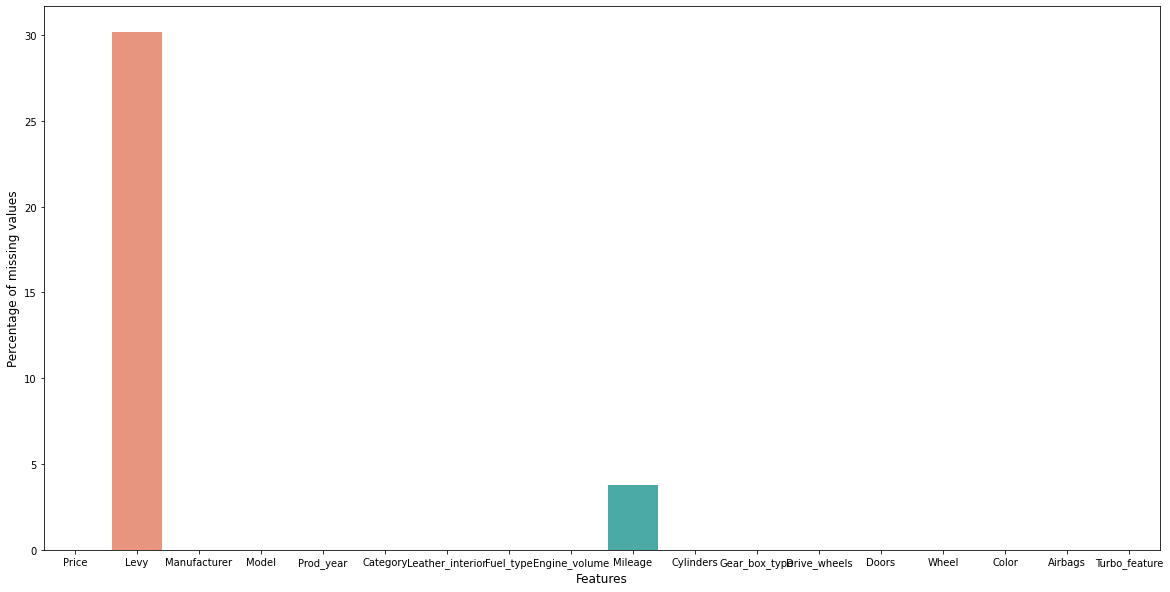
Step_4 Type Casting and Replacing Null
Perform type casting to further treat them.
# Changing data type of levy column
df['Levy'] = df['Levy'].astype(float)
# Droping Km in Mileage column to convert it to numeric
df['Mileage'] = df['Mileage'].str.replace('km', '')
# Convert Mileage column to numeric
df['Mileage'] = pd.to_numeric(df['Mileage'])
# Now again checking the data type of Mileage column
df[['Mileage','Levy']].dtypesMileage float64
Levy float64
dtype: objectWe can see that the percentage of missing values in Levy and Mileage column is low.
# Replacing missing values in Mileage column with mean value
df['Mileage'].fillna(df['Mileage'].mean(), inplace=True)
# Replacing missing values in Levy column with mean value
df['Levy'].fillna(df['Levy'].mean(), inplace=True)# Now again checking the number of missing values in each column
df.isnull().sum()Price 0
Levy 0
Manufacturer 0
Model 0
Prod_year 0
Category 0
Leather_interior 0
Fuel_type 0
Engine_volume 0
Mileage 0
Cylinders 0
Gear_box_type 0
Drive_wheels 0
Doors 0
Wheel 0
Color 0
Airbags 0
Turbo_feature 0
dtype: int64Treating door column.
- It has value in ‘04-May’ it means that the car has four doors, ‘02-Mar’ means two doors and ‘>5’ mean more than 5 doors.
- We changing it by the following codes;
# Repalcing -may and -mar with space in door column
df['Doors'] = df['Doors'].str.replace('-May', ' ')
df['Doors'] = df['Doors'].str.replace('-Mar', ' ')
df['Doors'] = df['Doors'].str.replace('>5', '6')
df['Doors'] = pd.to_numeric(df['Doors'])
df['Doors'].unique() array([4, 2, 6], dtype=int64)Treating Leather_interior column
Converting it into boolean type
df['Leather_interior'] = df['Leather_interior'].map({'Yes': True,
'No': False})
df['Leather_interior'].unique()array([ True, False])We noticed that more than 3500 values of price column is less than $1000. So, we can replace it with the mean of price column.
# Replacing values which is less than 1000 of price column with null value
df['Price'] = np.where(df['Price'] < 1000,
df['Price'].mean(), df['Price'])Step_5 Identification of Outliers
df.select_dtypes(include='number')| Price | Levy | Prod_year | Engine_volume | Mileage | Cylinders | Doors | Airbags | |
|---|---|---|---|---|---|---|---|---|
| 0 | 13328.000000 | 1399.000000 | 2010 | 3.5 | 186005.0 | 6.0 | 4 | 12 |
| 1 | 16621.000000 | 1018.000000 | 2011 | 3.0 | 192000.0 | 6.0 | 4 | 8 |
| 2 | 8467.000000 | 906.299205 | 2006 | 1.3 | 200000.0 | 4.0 | 4 | 2 |
| 3 | 3607.000000 | 862.000000 | 2011 | 2.5 | 168966.0 | 4.0 | 4 | 0 |
| 4 | 11726.000000 | 446.000000 | 2014 | 1.3 | 91901.0 | 4.0 | 4 | 4 |
| ... | ... | ... | ... | ... | ... | ... | ... | ... |
| 19232 | 8467.000000 | 906.299205 | 1999 | 2.0 | 300000.0 | 4.0 | 2 | 5 |
| 19233 | 15681.000000 | 831.000000 | 2011 | 2.4 | 161600.0 | 4.0 | 4 | 8 |
| 19234 | 26108.000000 | 836.000000 | 2010 | 2.0 | 116365.0 | 4.0 | 4 | 4 |
| 19235 | 5331.000000 | 1288.000000 | 2007 | 2.0 | 51258.0 | 4.0 | 4 | 4 |
| 19236 | 18587.435267 | 753.000000 | 2012 | 2.4 | 186923.0 | 4.0 | 4 | 12 |
18924 rows × 8 columns
# Detecting outliers in numeric columns
cols=['Price' , 'Levy' , 'Prod_year' ,
'Engine_volume', 'Mileage','Cylinders', 'Doors' , 'Airbags']cat_cols = ['Price' , 'Levy' , 'Prod_year' ,
'Engine_volume','Mileage', 'Airbags']
i=0
while i < 6:
fig = plt.figure(figsize=[25,4])
#ax1 = fig.add_subplot(121)
#ax2 = fig.add_subplot(122)
#ax1.title.set_text(cat_cols[i])
plt.subplot(1,3,1)
sns.boxplot(x=cat_cols[i], data=df)
i += 1
#ax2.title.set_text(cat_cols[i])
plt.subplot(1,3,2)
sns.boxplot(x=cat_cols[i], data=df)
i += 1
plt.show()


Step_6 Treating Outliers
# Function for imputing outliers in numeric columns
def impute_outliers_IQR(df):
q1=df.quantile(0.25)
q3=df.quantile(0.75)
IQR=q3-q1
upper = df[~(df>(q3+1.5*IQR))].max()
lower = df[~(df<(q1-1.5*IQR))].min()
df = np.where(df > upper,
df.mean(),
np.where(
df < lower,
df.mean(),
df
)
)
return df# Impute outliers in numeric columns
df['Levy'] = impute_outliers_IQR(df['Levy'])
df['Engine_volume'] = impute_outliers_IQR(df['Engine_volume'])
df['Mileage'] = impute_outliers_IQR(df['Mileage'])
df['Price'] = impute_outliers_IQR(df['Price'])old_cars = df[df['Prod_year']<=1980] #for graph purpose
df = df[df['Prod_year']>1980] #update by droping few entries to improve outlier condition
# Set index to production year
plt.figure(figsize=(20,5))
old_cars.set_index('Prod_year', inplace=True)
# Creating histogram
fig, ax = plt.subplots(figsize =(10, 7))
ax.hist(df['Prod_year'],
bins = [1980, 1990, 2000, 2010, 2020])
# Show plot
plt.xlabel('Production Year')
plt.ylabel('Count')
plt.show()
df.shape<Figure size 1440x360 with 0 Axes>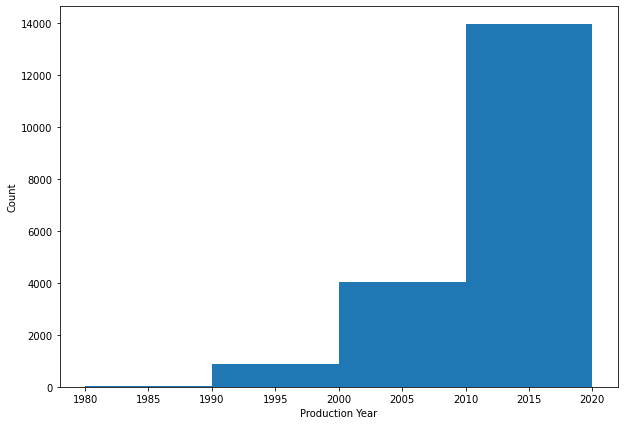
(18900, 18)# After treatment
cat_cols = ['Price' , 'Levy' , 'Prod_year' ,
'Engine_volume','Mileage', 'Airbags']
i=0
while i < 6:
fig = plt.figure(figsize=[25,4])
#ax1 = fig.add_subplot(121)
#ax2 = fig.add_subplot(122)
#ax1.title.set_text(cat_cols[i])
plt.subplot(1,3,1)
sns.boxplot(x=cat_cols[i], data=df,
color='gray')
i += 1
#ax2.title.set_text(cat_cols[i])
plt.subplot(1,3,2)
sns.boxplot(x=cat_cols[i], data=df ,
color='gray')
i += 1
plt.show()


Step_7 Statistics of the dataset
# Summary of the dataset
df.describe()| Price | Levy | Prod_year | Engine_volume | Mileage | Cylinders | Doors | Airbags | |
|---|---|---|---|---|---|---|---|---|
| count | 18900.000000 | 18900.000000 | 18900.000000 | 18900.000000 | 1.890000e+04 | 18900.000000 | 18900.000000 | 18900.000000 |
| mean | 16141.012594 | 843.131874 | 2010.975979 | 2.161860 | 2.350861e+05 | 4.579841 | 3.932593 | 6.574074 |
| std | 8502.455447 | 145.360334 | 5.374868 | 0.578718 | 3.782742e+05 | 1.199205 | 0.427513 | 4.319844 |
| min | 1000.000000 | 456.000000 | 1981.000000 | 0.800000 | 1.300000e+01 | 1.000000 | 2.000000 | 0.000000 |
| 25% | 9565.000000 | 765.000000 | 2009.000000 | 1.800000 | 7.908000e+04 | 4.000000 | 4.000000 | 4.000000 |
| 50% | 17249.000000 | 906.299205 | 2012.000000 | 2.000000 | 1.343860e+05 | 4.000000 | 4.000000 | 6.000000 |
| 75% | 21005.730841 | 906.299205 | 2015.000000 | 2.500000 | 2.000000e+05 | 4.000000 | 4.000000 | 12.000000 |
| max | 40769.000000 | 1197.000000 | 2020.000000 | 3.500000 | 1.616358e+06 | 16.000000 | 6.000000 | 16.000000 |
#for categorical data
df.describe(include=['O']).T| count | unique | top | freq | |
|---|---|---|---|---|
| Manufacturer | 18900 | 64 | HYUNDAI | 3729 |
| Model | 18900 | 1578 | Prius | 1069 |
| Category | 18900 | 11 | Sedan | 8593 |
| Fuel_type | 18900 | 7 | Petrol | 9922 |
| Gear_box_type | 18900 | 4 | Automatic | 13276 |
| Drive_wheels | 18900 | 3 | Front | 12693 |
| Wheel | 18900 | 2 | Left-hand drive | 17447 |
| Color | 18900 | 16 | Black | 4942 |
Step_8 Data Visualization
Univariate and Bivariate/Multivariate Analysis and Graphs
cat_cols = ['Fuel_type','Gear_box_type',
'Drive_wheels','Wheel', 'Doors', 'Leather_interior']
i=0
while i < 6:
fig = plt.figure(figsize=[20,4])
#ax1 = fig.add_subplot(121)
#ax2 = fig.add_subplot(122)
#ax1.title.set_text(cat_cols[i])
plt.subplot(1,3,1)
sns.countplot(x=cat_cols[i], data=df)
i += 1
#ax2.title.set_text(cat_cols[i])
plt.subplot(1,3,2)
sns.countplot(x=cat_cols[i], data=df)
i += 1
#ax3.title.set_text(cat_cols[i])
plt.subplot(1,3,3)
sns.countplot(x=cat_cols[i], data=df)
i += 1
plt.show()

sns.lineplot(data=df, x="Prod_year", y="Price") #drop confidence interval 200,000
plt.ylim(0,50000)
plt.xlabel("Production Year") #drop confidence interval 200,000Text(0.5, 0, 'Production Year')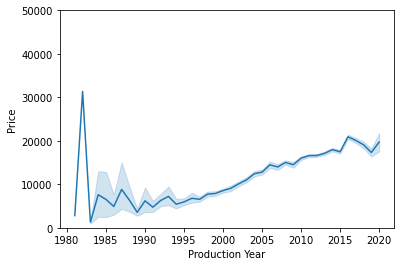
sns.barplot(x="Cylinders", y="Price", data=df) <AxesSubplot:xlabel='Cylinders', ylabel='Price'>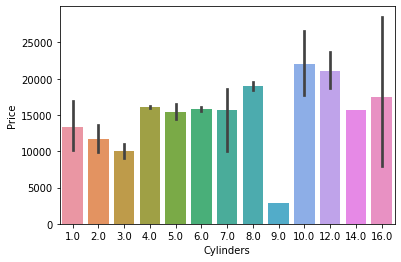
# Checking the normality of the each column
plt.figure(figsize=(10,10))
sns.distplot(df['Levy'])c:\Users\WASIF\AppData\Local\Programs\Python\Python310\lib\site-packages\seaborn\distributions.py:2619: FutureWarning: `distplot` is a deprecated function and will be removed in a future version. Please adapt your code to use either `displot` (a figure-level function with similar flexibility) or `histplot` (an axes-level function for histograms).
warnings.warn(msg, FutureWarning)<AxesSubplot:xlabel='Levy', ylabel='Density'>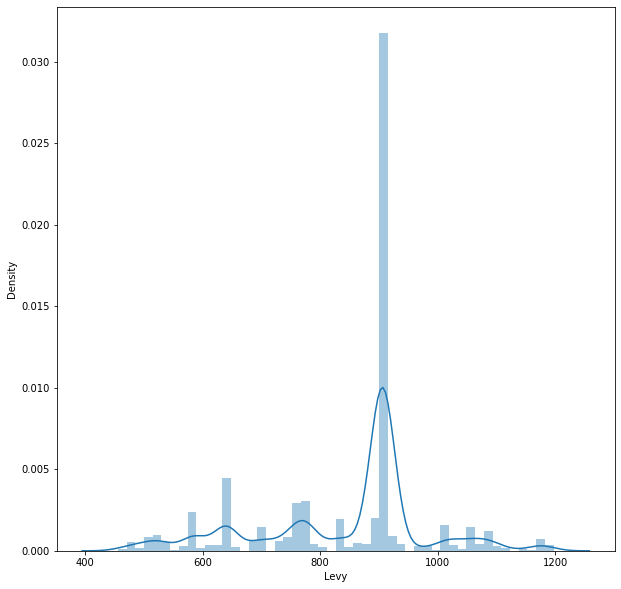
# Normality of mileage column
plt.figure(figsize=(10,10))
sns.distplot(df['Mileage'])c:\Users\WASIF\AppData\Local\Programs\Python\Python310\lib\site-packages\seaborn\distributions.py:2619: FutureWarning: `distplot` is a deprecated function and will be removed in a future version. Please adapt your code to use either `displot` (a figure-level function with similar flexibility) or `histplot` (an axes-level function for histograms).
warnings.warn(msg, FutureWarning)<AxesSubplot:xlabel='Mileage', ylabel='Density'>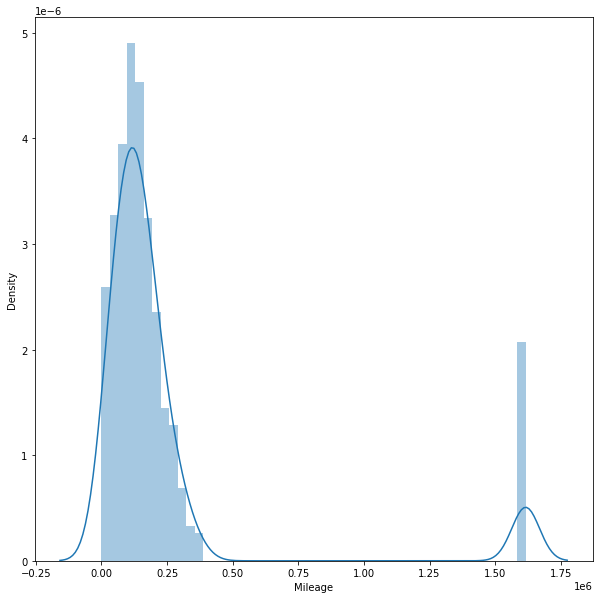
# Normality of price column
plt.figure(figsize=(10,10))
sns.distplot(df['Price'])c:\Users\WASIF\AppData\Local\Programs\Python\Python310\lib\site-packages\seaborn\distributions.py:2619: FutureWarning: `distplot` is a deprecated function and will be removed in a future version. Please adapt your code to use either `displot` (a figure-level function with similar flexibility) or `histplot` (an axes-level function for histograms).
warnings.warn(msg, FutureWarning)<AxesSubplot:xlabel='Price', ylabel='Density'>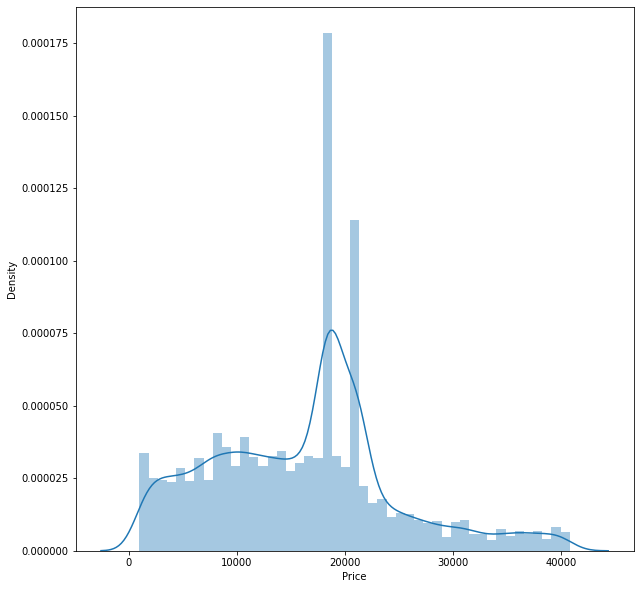
# Normal distribution of Production year column
plt.figure(figsize=(10,10))
sns.distplot(df['Prod_year'])c:\Users\WASIF\AppData\Local\Programs\Python\Python310\lib\site-packages\seaborn\distributions.py:2619: FutureWarning: `distplot` is a deprecated function and will be removed in a future version. Please adapt your code to use either `displot` (a figure-level function with similar flexibility) or `histplot` (an axes-level function for histograms).
warnings.warn(msg, FutureWarning)<AxesSubplot:xlabel='Prod_year', ylabel='Density'>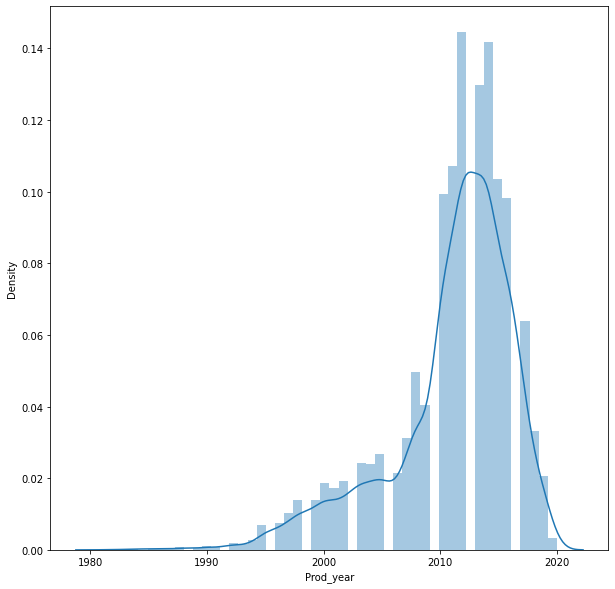
Skewness and kurtosis of the above columns
# Skewness of each column
df.skew()C:\Users\WASIF\AppData\Local\Temp\ipykernel_1480\546654255.py:2: FutureWarning: Dropping of nuisance columns in DataFrame reductions (with 'numeric_only=None') is deprecated; in a future version this will raise TypeError. Select only valid columns before calling the reduction.
df.skew()Price 0.424448
Levy -0.586999
Prod_year -1.305213
Leather_interior -1.013990
Engine_volume 0.691372
Mileage 3.219546
Cylinders 2.111889
Doors -2.974352
Airbags 0.085803
Turbo_feature 2.666878
dtype: float64# kurtois of each column
df.kurt()C:\Users\WASIF\AppData\Local\Temp\ipykernel_1480\1707974930.py:2: FutureWarning: Dropping of nuisance columns in DataFrame reductions (with 'numeric_only=None') is deprecated; in a future version this will raise TypeError. Select only valid columns before calling the reduction.
df.kurt()Price 0.126193
Levy 0.136991
Prod_year 1.868845
Leather_interior -0.971927
Engine_volume -0.005464
Mileage 8.943932
Cylinders 6.612642
Doors 17.410370
Airbags -1.331828
Turbo_feature 5.112781
dtype: float64# Correlation matrix of the dataset
corr = df.corr()
# Heatmap of the correlation matrix of the dataset
plt.figure(figsize=(20,10))
sns.heatmap(corr, annot=True)<AxesSubplot:>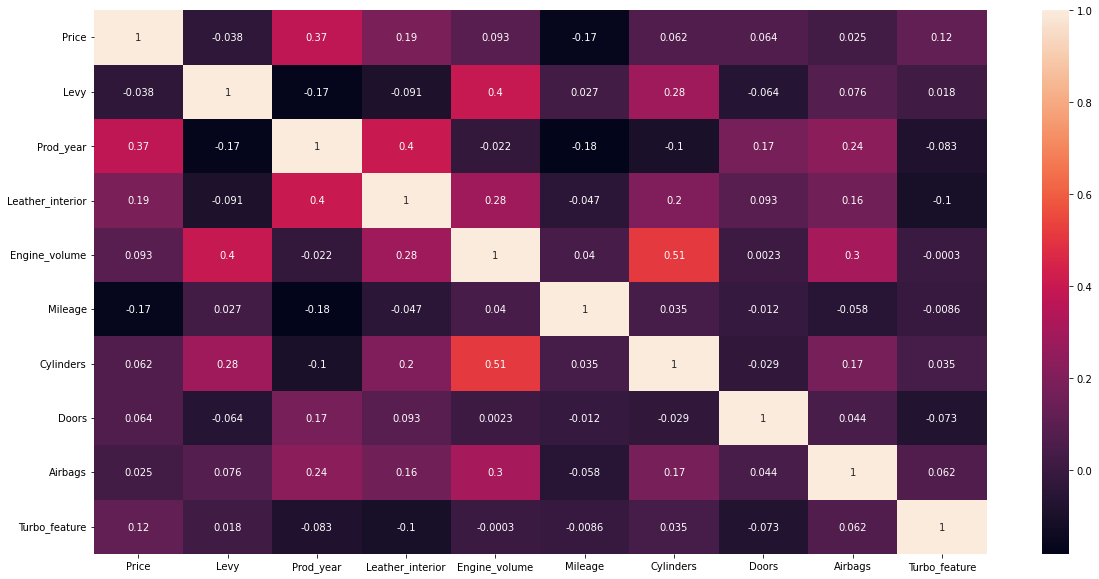
4- Conclusion
Wide variety of manufacturer and car variants are studied having 19237 rows and 18 column in original data set. One column adding no information to data was dropped from the data set. Null values and outlier were treated through mean mutation.
Majority of the cars bought and popular among public are having following features:
- Petrol
- Left hand drive
- Door with 4-cars
- Interior with leather setting
- Gear box having auto-transmission
- Front wheels drive